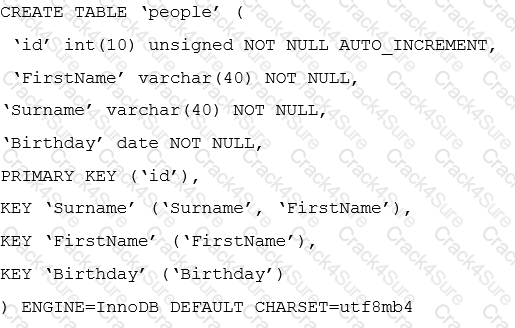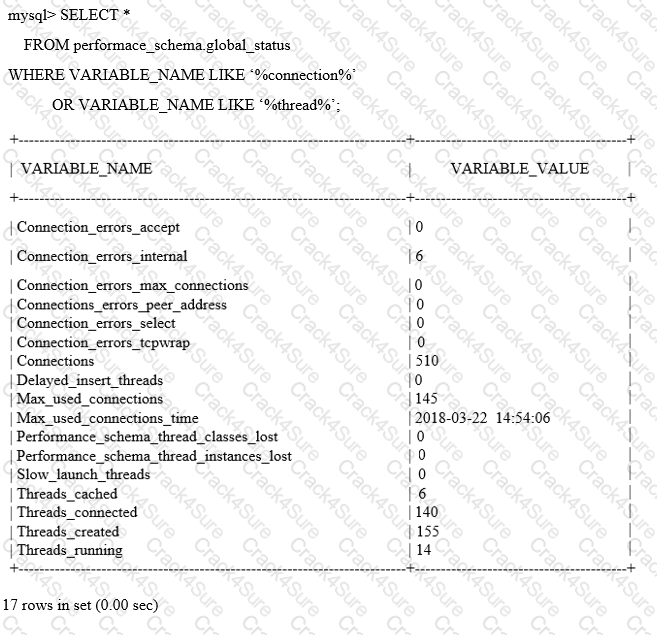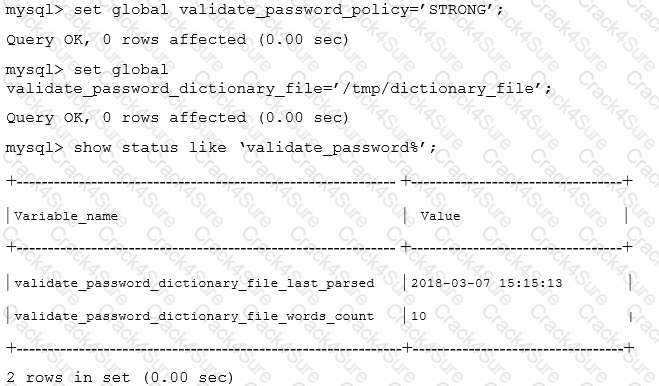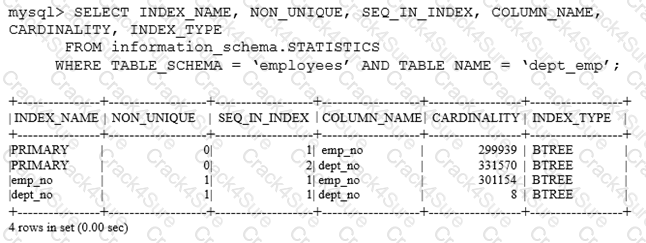We at Crack4sure are committed to giving students who are preparing for the Oracle 1z0-888 Exam the most current and reliable questions . To help people study, we've made some of our MySQL 5.7 Database Administrator exam materials available for free to everyone. You can take the Free 1z0-888 Practice Test as many times as you want. The answers to the practice questions are given, and each answer is explained.
The MySQL user ‘adam’ currently has USAGE permissions to the database.
The football database is transactional and has non-stop updates from application users. The ‘adam’ user needs to be able to take consistent backups of the football database by using the –-single-transaction option.
Which extra GRANT permissions are required for adam to take mysqldump backups?
You have just executed a manual backup by using this command:
mysqlbackup –u root –p –-socket=/tmp/my.sock –-backup-dir=/my/backup/ backup
The operation completed without error.
What is the state of this backup and operation required before it is ready to be restored?
What is the best method for monitoring Group Replication conflict resolution?
Consider the table people with this definition:

The application uses a query such as:
SELECT * FROM people WHERE YEAR(Birthday) = 1980;
The query is not using an index.
Which two methods can be used to allow the query to use an index? (Choose two.)
Multiversion Concurrency Control (MVCC) enables what type of backup?
A MySQL instance has this configuration values set:

A transaction involving a single InnoDB INSERT statement commits.
Which list of locations is in the sequence of disk writes for this transaction?
Which two statements are true regarding the creating of new MySQL physical and logical backups? (Choose two.)
Which two options describe how MySQL Server allocates memory? (Choose two.)
Consider that local disk files are accessible via MySQL with commands such as:
mysql> LOAD DATA LOCAL INFILE ‘/etc/passwd’ INTO TABLE mypasswords;
What change could be made to stop any breach via this insecurity?
Consider these global status variables:

Which two conclusions can be made from the output? (Choose two.)
You have a consistent InnoDB backup created with mysqldump, the largest table is 50 GB in size.
You start to restore your backup with this command;
shell> mysql –u root –p < backup.sql
After 30 minutes, you notice that the rate of restore seems to have slowed down. No other processes or external factors are affecting server performance.
Which is the most likely explanation for this slowdown?
An admin attempts to enforce stronger security by using these commands:

The admin then leaves the system running with the specified changes. What are two remaining security concerns? (Choose two.)
Which two statements are true about InnoDB auto-increment locking? (Choose two.)
A crucial database, ‘db_prod’, just disappeared from your production MySQL instance.
In reviewing the available MySQL logs (General, Audit, or Slow) and your own application-level logs, you identified this command from a customer facing application:
SELECT id FROM users WHERE login=’payback!’;DROP DATABASE db_prod;’
Which three methods could have been used to prevent this SQL injection attack from happening? (Choose three.)
Which statement describes how the relay log works?
After analysis on the slow query log on a high-end OLTP service, the table identified in the slow queries is:

What are the two most likely reasons for the slowness given this output? (Choose two.)
Consider the index information for the dept_emp table in the employee’s schema:

Which two conclusions can be made based on the output of the query? (Choose two.)
You are no longer able to log in to an existing MySQL Server because the root password credentials not working. You need to reset the root password to complete various administrative tasks. What are the two major methods that will achieve this? (Choose two.)
Which three allocate memory per thread in MySQL? (Choose three.)
You want to create a temporary table named OLD_INVENTORY in the OLD_INVENTORY database on the master server. This table is not to be replicated to the slave server.
Which two changes would ensure that the temporary table does not propagate to the slave? (Choose two.)
You are creating a strategy for backing up MySQL using a cold binary backup. The MySQL instance is a replication master with global transaction identifiers (GTIDs) enabled and it uses Transparent Data Encryption (TDE). Other than the configuration required to make the instance a replication master and enabled GTIDs and TDE, the instance is using all default settings.
The requirements for the backup are:
Which four steps must be included in the backup strategy? (Choose four.)
Consider the CHECK TABLE command.
In which two situations should this command be used? (Choose two.)
You enable binary logging on MySQL Server with the configuration:
binlog-format=STATEMENT
log-bin
Which database updates are logged on the master server to the binary log by default?
Which three options are most likely to be changed for production form their default values? (Choose three.)
To satisfy a security requirement, you have created or altered some user accounts to include REQUIRE X509.
Which additional task needs to be performed for those user accounts to fulfill the requirement to use X509?
A MySQL instance is running on a dedicated server. Developers access the server from the same network subnet. Users access the database through an application that is running on a separate server in a DMZ.
Which two will optimize the security of this setup? (Choose two.)
You have just created a replication slave from a backup of the master made with mysqldump:

You try to log in to the slave with the application user, but fail as follows:

The login works on the master.
Which two changes to the process can fix the issue?
You are using GTIDS in replication. You need to skip a transaction with the GTID of aaa-bbb-ccc-ddd-eee:3 on a slave.
Which procedure would you execute from a MySQL prompt?
Where does MySQL Linux RPM install the mysqld binary?
You are setting up a new installation of MySQL Server 5.7 (a GA release.) You have used a ZIP or TAR package to ensure that the mysqld binary, along with its support files, such as plug-ins and error messages, now exist on the host. Assume that the default datadir exists on the host. You installed the binary in the default location (the default --basedir value) for your operating system.
Which step should you perform before defining your own databases and database tables?
Which two statements describe how InnoDB recovery works? (Choose two.)
An existing master-slave setup is currently using a delayed replication of one hour. The master has crashed and the slave must be “rolled forward” to provide all the latest data.
The SHOW SLAVE STATUS indicates these values:
Which command set would make the slave current?
3 Months Free Update
3 Months Free Update
3 Months Free Update